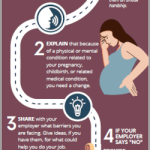Examples of Reasonable Accommodations for Pregnant Workers: Supporting a Healthy Pregnancy

As we all know, pregnancy can be a wonderful experience, but it can also come with its own set of challenges. For pregnant workers, these challenges can be especially tough to navigate in the workplace. That’s where reasonable accommodations come in – changes to the work environment or job duties that allow pregnant workers to perform their jobs safely and comfortably.
In this article, we’ll explore what constitutes a reasonable accommodation and provide some examples of reasonable accommodations for pregnant workers. We’ll also discuss the importance of creating a supportive work environment for pregnant workers and provide tips for employers and employees to work together to make necessary accommodations.
What Constitutes a Reasonable Accommodation?
A reasonable accommodation is a modification or adjustment to the work environment or job duties that allows an employee with a disability – including pregnancy-related disabilities – to perform their job safely and effectively. The goal of a reasonable accommodation is to provide equal access to employment opportunities and to prevent discrimination against employees with disabilities.
When it comes to pregnancy, reasonable accommodations can vary depending on the individual’s needs. Some common examples of reasonable accommodations for pregnant workers include:
- Modifying Work Schedules: This can include changing work hours, job duties, or providing regular breaks to help manage fatigue and other pregnancy-related symptoms.
- Providing Ergonomic Furniture: This can include providing a comfortable chair, a supportive backrest, or a lift to help reduce strain on the back and legs.
Examples of Reasonable Accommodations for Pregnant Workers
Here are some examples of reasonable accommodations for pregnant workers:
Job Restructuring
- Temporarily reassigning duties that require heavy lifting or bending
- Providing a temporary transfer to a different role or department
- Modifying job duties to reduce exposure to hazardous materials or conditions
Workplace Modifications
- Providing a private area for breastfeeding or expressing milk
- Installing grab bars or handrails in restrooms or other areas
- Providing a comfortable chair or couch for rest breaks
Leave and Time Off
- Providing temporary leave or time off for prenatal care or appointments
- Offering flexible scheduling to accommodate fetal development monitoring
- Providing unpaid leave for pregnant workers who need to take time off due to pregnancy-related complications
Ergonomic and Comfort Accommodations
- Providing a back support or ergonomic chair
- Installing a lift or assistive device to reduce strain on the back and legs
- Offering a comfortable and supportive pillow or cushion for rest breaks
Importance of Creating a Supportive Work Environment
Creating a supportive work environment for pregnant workers is crucial for ensuring their health, safety, and well-being. By providing reasonable accommodations, employers can help reduce the risk of pregnancy-related complications and promote a positive work experience.
Some benefits of creating a supportive work environment for pregnant workers include:
- Increased Productivity: By providing reasonable accommodations, employers can help pregnant workers maintain their productivity and perform their jobs safely and effectively.
- Improved Morale: A supportive work environment can boost morale and job satisfaction, reducing the risk of turnover and absenteeism.
- Reduced Risk of Pregnancy-Related Complications: By providing reasonable accommodations, employers can help reduce the risk of pregnancy-related complications, such as preterm labor or gestational diabetes.
Tips for Employers and Employees
Here are some tips for employers and employees to work together to provide reasonable accommodations:
- Open Communication: Encourage open communication between employers and employees to discuss needs and concerns.
- Documentation: Keep accurate documentation of accommodations provided and any changes made to the work environment or job duties.
- Training: Provide training for managers and supervisors on pregnancy-related accommodations and disability rights.
Closing
In conclusion, providing examples of reasonable accommodations for pregnant workers is essential for creating a supportive work environment and promoting a healthy pregnancy. By understanding what constitutes a reasonable accommodation and working together to provide necessary modifications, employers and employees can promote a positive work experience and reduce the risk of pregnancy-related complications. Some examples of reasonable accommodations for pregnant workers include job restructuring, workplace modifications, leave and time off, and ergonomic and comfort accommodations. By creating a supportive work environment, employers can promote increased productivity, improved morale, and reduced risk of pregnancy-related complications.
<